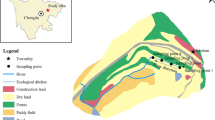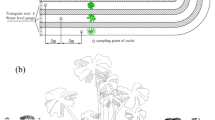Abstract
Constructed ditch wetland (CDW) is a combination of idle ditch and constructed wetland, which is typically used in rural areas to remove pollutants from domestic wastewater. However, its low total nitrogen (TN) removal remains a pressing issue. To enhance total nitrogen removal, an approach of supplying water at two locations in the CDW at different influent flow ratios, combined with artificial aeration, was proposed to adjust carbon and oxygen distribution in the system. The highest average TN removal was achieved at low influent concentration (CDW4; influent flow ratio 1:2). The removal of TN in winter and spring were 58.93 and 83.26%, respectively. The distribution of carbon sources in the back zone enhanced denitrification. Of the high influent concentration treatments, CDW2 (2:1) achieved 16.97% more TN removal on average compared with CDW1 (3:0), after extra artificial aeration was applied in the front zone. However, nitrification was a limiting step in the system, which became the primary problem preventing pollutant purification. Moreover, nitrifying bacteria abundance was negatively correlated to the influent flow ratio and autotrophic denitrifying bacterial abundance was positively correlated to the influent flow ratios.

Graphical abstract






Similar content being viewed by others
References
Altschul SF, Madden TL, Schäffer AA, Zhang J, Zhang Z, Miller W, Lipman DJ (1997) Gapped BLAST and PSI-BLAST: a new generation of protein database search programs. Nucleic Acids Res 25:3389–3402
AWWA (2017) Standard methods for the examination of water and wastewater. AWWA, Washington
Chen L, Liu F, Wang Y, Li X, Zhang S, Li Y, Wu J (2015) Nitrogen removal in an ecological ditch receiving agricultural drainage in subtropical Central China. Ecol Eng 82:487–492
Coyotzi S, Pratscher J, Murrell JC, Neufeld JD (2016) Targeted metagenomics of active microbial populations with stable-isotope probing. Curr Opin Biotechnol 41:1–8
DeSantis TZ, Hugenholtz P, Larsen N, Rojas M, Brodie EL, Keller K, Huber T, Dalevi D, Hu P, Andersen GL (2006) Greengenes, a chimera-checked 16S rRNA gene database and workbench compatible with ARB. Appl Environ Microbiol 72:5069–5072
Ding Y, Song X, Wang Y, Yan D (2012) Effects of dissolved oxygen and influent COD/N ratios on nitrogen removal in horizontal subsurface flow constructed wetland. Ecol Eng 46:107–111
Du R, Cao S, Li B, Niu M, Wang S, Peng Y (2017) Performance and microbial community analysis of a novel DEAMOX based on partial-denitrification and anammox treating ammonia and nitrate wastewaters. Water Res 108:46–56
Edgar RC (2010) Search and clustering orders of magnitude faster than BLAST. Bioinformatics 26:2460–2461
Ejiri M, Shiono K (2019) Prevention of radial oxygen loss is associated with exodermal suberin along adventitious roots of annual wild species of Echinochloa. Front Plant Sci 10:254–254
Fan J, Zhang B, Zhang J, Ngo HH, Guo W, Liu F, Guo Y, Wu H (2013) Intermittent aeration strategy to enhance organics and nitrogen removal in subsurface flow constructed wetlands. Bioresour Technol 141:117–122
Green SJ, Prakash O, Jasrotia P, Overholt WA, Cardenas E, Hubbard D, Tiedje JM, Watson DB, Schadt CW, Brooks SC, Kostka JE (2012) Denitrifying bacteria from the genus Rhodanobacter dominate bacterial communities in the highly contaminated subsurface of a nuclear legacy waste site. Appl Environ Microbiol 78:1039–1047
Guo Y, Xie H, Zhang J, Wang W, Hao Ngo H, Guo W, Kang Y, Zhang B (2018) Improving nutrient removal performance of surface flow constructed wetlands in winter using hardy submerged plant-benthic fauna systems. RSC Adv 8:42179–42188
Hu Y, Zhao Y, Zhao X, Kumar JLG (2012) High rate nitrogen removal in an alum sludge-based intermittent aeration constructed wetland. Environ Sci Technol 46:4583–4590
Huang J, Cao C, Yan C, Guan W, Liu J (2018) Comparison of Iris pseudacorus wetland systems with unplanted systems on pollutant removal and microbial community under nanosilver exposure. Sci Total Environ 624:1336–1347
Jaubert JM (1991) System for biological purification of water containing organic materials and derivative products. US4995980A
Kadlec RH (2009) Comparison of free water and horizontal subsurface treatment wetlands. Ecol Eng 35:159–174
Lee C, Fletcher TD, Sun G (2009) Nitrogen removal in constructed wetland systems. Eng Life Sci 9:11–22
Li F, Lu L, Zheng X, Zhang X (2014) Three-stage horizontal subsurface flow constructed wetlands for organics and nitrogen removal: effect of aeration. Ecol Eng 68:90–96
Liu H, Hu Z, Zhang J, Ngo HH, Guo W, Liang S, Fan J, Lu S, Wu H (2016) Optimizations on supply and distribution of dissolved oxygen in constructed wetlands: a review. Bioresour Technol 214:797–805
Lu S, Hu H, Sun Y, Yang J (2009) Effect of carbon source on the denitrification in constructed wetlands. J Environ Sci 21:1036–1043
Lv P, Luo J, Zhuang X, Zhang D, Huang Z, Bai Z (2017) Diversity of culturable aerobic denitrifying bacteria in the sediment, water and biofilms in Liangshui River of Beijing, China. Sci Rep 7:10032
Ma J, Wang Z, He D, Li Y, Wu Z (2015) Long-term investigation of a novel electrochemical membrane bioreactor for low-strength municipal wastewater treatment. Water Res 78:98–110
Matheson FE, Sukias JP (2010) Nitrate removal processes in a constructed wetland treating drainage from dairy pasture. Ecol Eng 36:1260–1265
Mburu N, Rousseau DPL, van Bruggen JJA, Thumbi G, Llorens E, García J, Lens PNL (2013) Reactive transport simulation in a tropical horizontal subsurface flow constructed wetland treating domestic wastewater. Sci Total Environ 449:309–319
Nguyen VK, Hong S, Park Y, Jo K, Lee T (2015) Autotrophic denitrification performance and bacterial community at biocathodes of bioelectrochemical systems with either abiotic or biotic anodes. J Biosci Bioeng 119:180–187
Nivala J, Wallace S, Headley T, Kassa K, Brix H, van Afferden M, Müller R (2013) Oxygen transfer and consumption in subsurface flow treatment wetlands. Ecol Eng 61:544–554
Peng L, Liu Y, Gao S-H, Chen X, Xin P, Dai X, Ni B-J (2015) Evaluation on the nanoscale zero valent iron based microbial denitrification for nitrate removal from groundwater. Sci Rep 5:12331
Prakash O, Green SJ, Jasrotia P, Overholt WA, Canion A, Watson DB, Brooks SC, Kostka JE (2012) Rhodanobacter denitrificans sp. nov., isolated from nitrate-rich zones of a contaminated aquifer. Int J Syst Evol Microbiol 62:2457–2462
Puigagut J, Caselles-Osorio A, Vaello N, García J (2008) Fractionation, biodegradability and particle-size distribution of organic matter in horizontal subsurface-flow constructed wetlands. In: Wastewater treatment, plant dynamics and management in constructed and natural wetlands. Springer Netherlands, Dordrecht, pp 289–297
Rivett MO, Buss SR, Morgan P, Smith JWN, Bemment CD (2008) Nitrate attenuation in groundwater: a review of biogeochemical controlling processes. Water Res 42:4215–4232
Saeed T, Muntaha S, Rashid M, Sun G, Hasnat A (2018) Industrial wastewater treatment in constructed wetlands packed with construction materials and agricultural by-products. J Clean Prod 189:442–453
Shen Y, Yang D, Wu Y, Zhang H, Zhang X (2019) Operation mode of a step-feed anoxic/oxic process with distribution of carbon source from anaerobic zone on nutrient removal and microbial properties. Sci Rep 9:1153
Smith CJ, Dong LF, Wilson J, Stott A, Osborn AM, Nedwell DB (2015) Seasonal variation in denitrification and dissimilatory nitrate reduction to ammonia process rates and corresponding key functional genes along an estuarine nitrate gradient. Front Microbiol 6
Song S, Wang P, Liu Y, Zhao D, Leng X, An S (2019) Effects of Oenanthe javanica on nitrogen removal in free-water surface constructed wetlands under low-temperature conditions. Int J Environ Res Public Health 16:1420
Straub KL, Schönhuber WA, Buchholz-Cleven BEE, Schink B (2004) Diversity of ferrous iron-oxidizing, nitrate-reducing bacteria and their involvement in oxygen-independent iron cycling. Geomicrobiol J 21:371–378
Sun Z, Lv Y, Liu Y, Ren R (2016) Removal of nitrogen by heterotrophic nitrification-aerobic denitrification of a novel metal resistant bacterium Cupriavidus sp. S1. Bioresour Technol 220:142–150
Trois C, Coulon F, de Combret CP, Martins JMF, Oxarango L (2010) Effect of pine bark and compost on the biological denitrification process of non-hazardous landfill leachate: focus on the microbiology. J Hazard Mater 181:1163–1169
van Kessel MAHJ, Speth DR, Albertsen M, Nielsen PH, Op den Camp HJM, Kartal B, Jetten MSM, Lücker S (2015) Complete nitrification by a single microorganism. Nature. 528:555–559
Vevelstad SJ, Johansen MT, Knuutila H, Svendsen HF (2014) Oxygen and temperature effect on formation of degradation compounds from MEA. Energy Procedia 63:957–975
Vymazal J (2011) Plants used in constructed wetlands with horizontal subsurface flow: a review. Hydrobiologia. 674:133–156
Vymazal J (2013) The use of hybrid constructed wetlands for wastewater treatment with special attention to nitrogen removal: a review of a recent development. Water Res 47:4795–4811
Wang C, Yang Y, Zhang Y (2011) Economic development, rural livelihoods, and ecological restoration: evidence from China. AMBIO. 40:78–87
Wu H, Zhang J, Ngo HH, Guo W, Hu Z, Liang S, Fan J, Liu H (2015) A review on the sustainability of constructed wetlands for wastewater treatment: design and operation. Bioresour Technol 175:594–601
Wu S, Wang H, Fan C, Zhou W, He S, Zheng X (2019) Intermittent operating characteristics of an ecological soil system with two-stage water distribution for wastewater treatment. Chemosphere. 215:8–14
Xu L, Zhao Y, Doherty L, Hu Y, Hao X (2016) Promoting the bio-cathode formation of a constructed wetland-microbial fuel cell by using powder activated carbon modified alum sludge in anode chamber. Sci Rep 6:26514
Xu L, Zhao Y, Wang X, Yu W (2018) Applying multiple bio-cathodes in constructed wetland-microbial fuel cell for promoting energy production and bioelectrical derived nitrification-denitrification process. Chem Eng J 344:105–113
Ye L, Zhang T (2011) Ammonia-oxidizing bacteria dominates over ammonia-oxidizing archaea in a saline nitrification reactor under low DO and high nitrogen loading. Biotechnol Bioeng 108:2544–2552
Zablotowicz RM, Eskew DL, Focht DD (1978) Denitrification in Rhizobium. Can J Microbiol 24:757–760
Zhou Q, Zhu H, Bañuelos G, Yan B, Liang Y, Yu J, Li H (2017) Impacts of vegetation and temperature on the treatment of domestic sewage in constructed wetlands incorporated with ferric-carbon micro-electrolysis material. Int J Phytoremediation 19:915–924
Acknowledgments
This work was financially supported by the Science and Technology Project of Zhejiang Province (No. 2015C03016), the National Natural Science Foundation of China (No. 51678356), the Program for Chinese National Key Projects of Water Pollution Control and Reclamation (2017ZX07205003) and the Science Foundation for Youths of Zhejiang Province (LQ19E080018).
Author information
Authors and Affiliations
Corresponding authors
Additional information
Responsible Editor: Alexandros Stefanakis
Publisher’s note
Springer Nature remains neutral with regard to jurisdictional claims in published maps and institutional affiliations.
Rights and permissions
About this article
Cite this article
Ma, Y., Zheng, P., Dai, W. et al. Pathways regulating nitrogen removal in constructed ditch wetlands: effects of different inflow ratios and artificial aeration. Environ Sci Pollut Res 27, 42571–42581 (2020). https://doi.org/10.1007/s11356-020-10224-1
Received:
Accepted:
Published:
Issue Date:
DOI: https://doi.org/10.1007/s11356-020-10224-1




